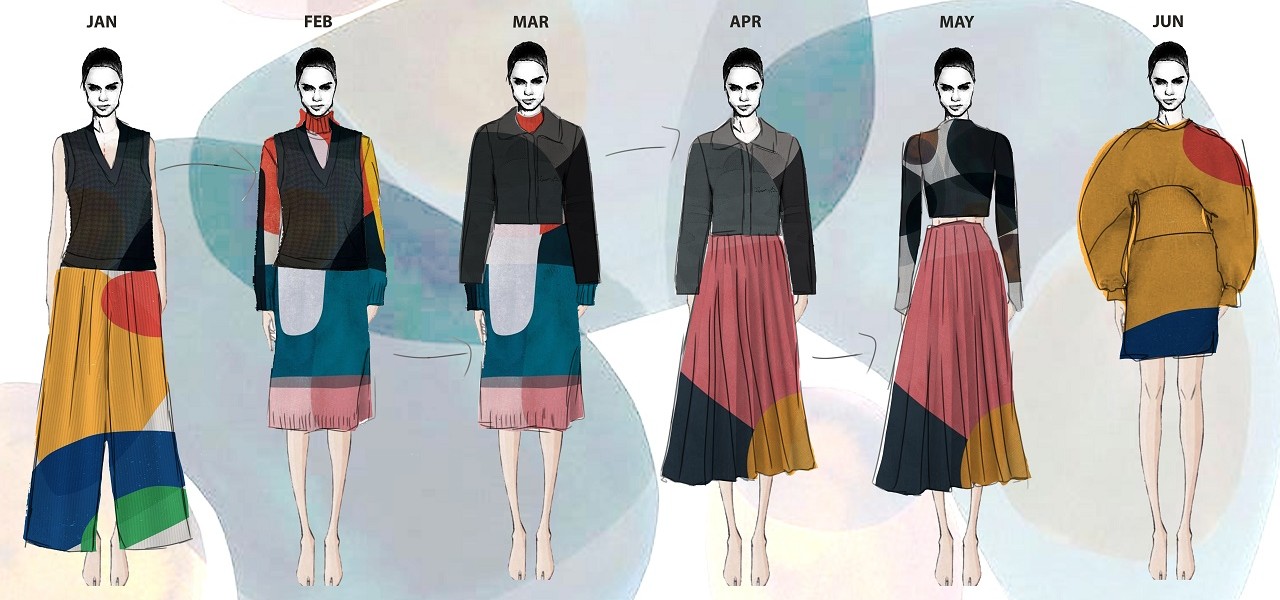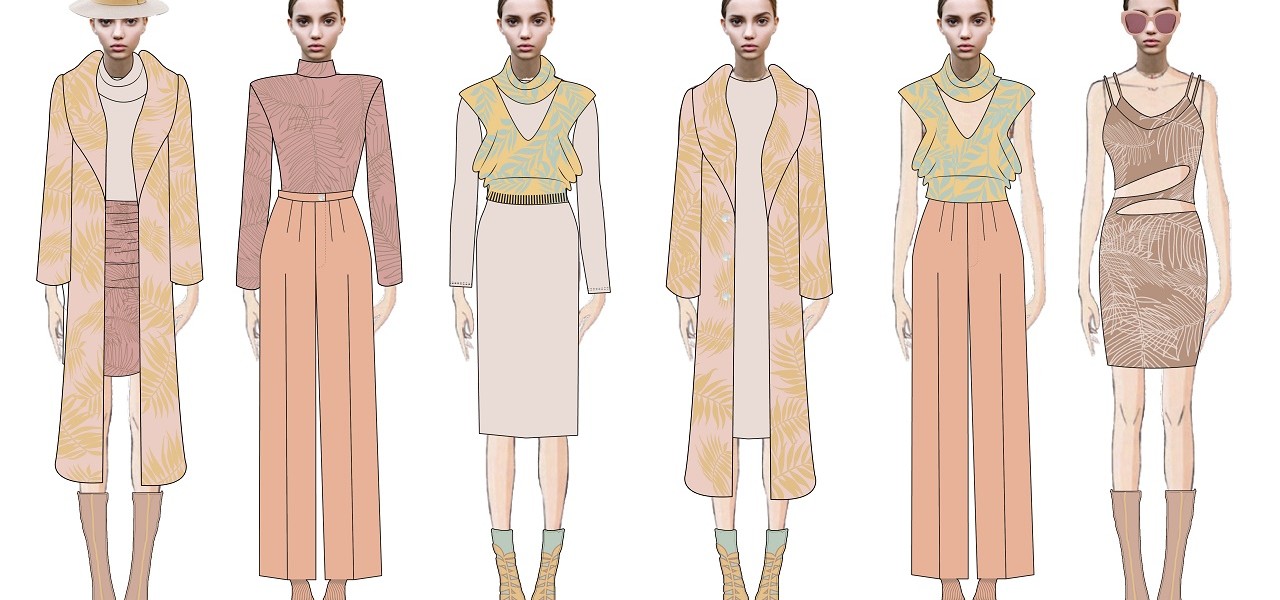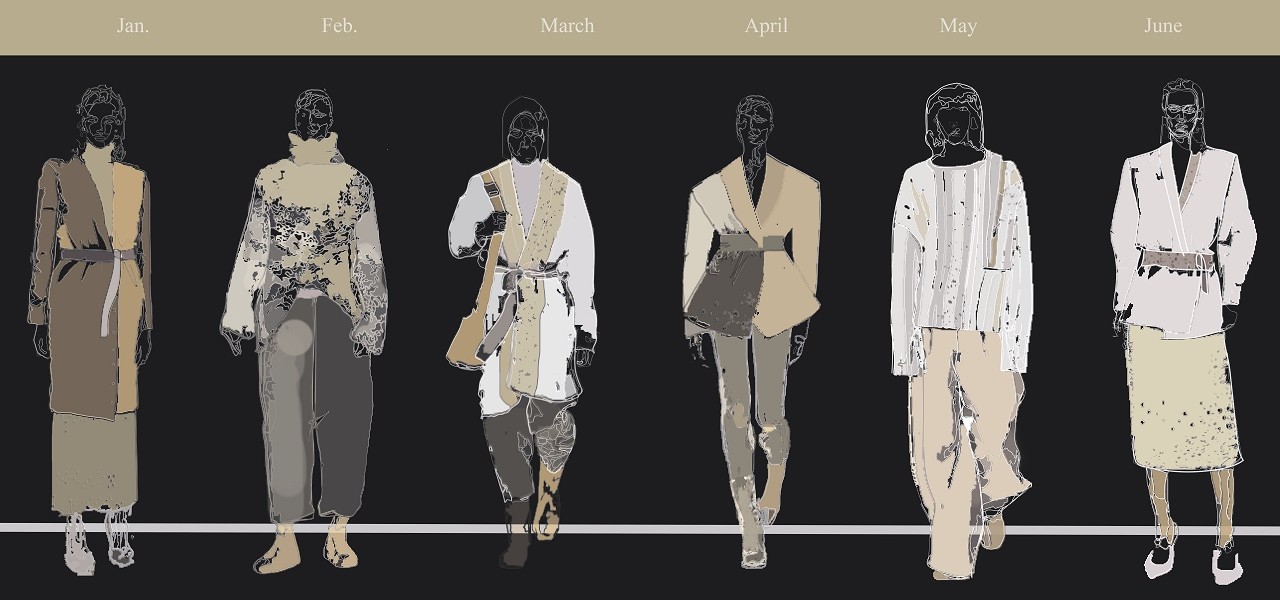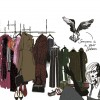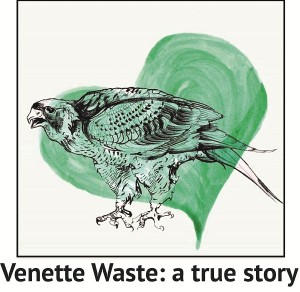L' economia circolare, l'economia del buon senso
Web Fashion Academy • 10 marzo, 2021
L'economia circolare è l'economia del buon senso, questo è il tema del seminario, che mi ha invitato a tenere la Facoltà del Design, membro associato dell'Università di Primorska in Slovenia.
Naturalmente, dati i tempi, tutta l'esperienza ha avuto il suo corso on line, ma non è stato difficile, in attesa di una prossima volta che non ci farà rinunciare al piacere della vicinanza e del poter visitare luoghi a me sconosciuti.
L'opportunità si è creata grazie a Mateja Benedetti fashion designer associata Web Fashion Academy nonchè eco-designer, basata a Lubjana.
Gli studenti del design, grazie a questo seminario, della moda sono stati invitati, non solo ad acquisire la conoscenza degli elementi e gli aspetti fondanti per cui un processo di produzione di beni possa essere definito circolare, ma anche a sviluppare in pochi giorni, rispettando le specifiche del protocollo di certificazione Waste Couture, 6 outfit uno per ogni mese dell'anno scelto prendendo a riferimento un semestre a piacimento.
L'impegno è stato sorprendente e ha dato come risultato ottimi lavori,
allora vi mostro e vi illustro il lavoro di:
Diellza Gashi
Lan Krebs
Meta Rogelj
Nagaya Florjan-Gorjup
Tamara Zorman
Pia Šilec
The circular economy is the economy of common sense, this is the theme of the seminar, which invited me to hold the Faculty of Design, associate member of the University of Primorska in Slovenia.
Of course, given the times we are living, the whole experience had its online course, but it was not difficult, but we will waiting for a next time that will not make us give up the pleasure of proximity and being able to visit places unknown to me.
The opportunity was created thanks to Mateja Benedetti fashion designer associated with Web Fashion Academy as well as eco-designer, based in Ljubljana precisely.
Thanks to this seminar, fashion design students were invited not only to acquire knowledge of the fundamental elements and aspects for which a process of production of goods can be defined as circular, but also to develop in a few days, respecting the specifications of the Waste Couture certification protocol, 6 outfits, one for each month of the year chosen, taking as reference a semester at will.
The effort has been amazing and has resulted in excellent works
So I'll show you and illustrate the work of:
Diellza Gashi
Lan Krebs
Meta Rogelj
Nagaya Florjan - Gorjup
Tamara Zorman
Pia Šilec
1) DIELLZA GASHI
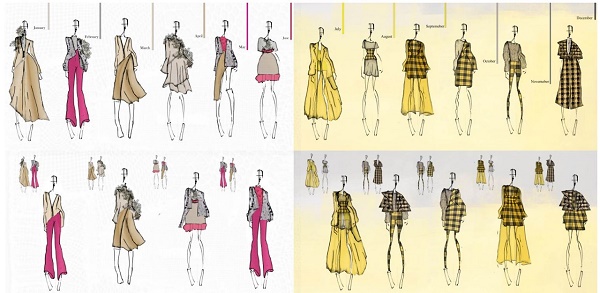
"The point of doing those two collection, was to use vintage materials and cloths that I already have it, which are very old and made from wool and cotton. As a part of this project and also this future, I have reused old laces with materials that are biodegradable. Those laces are very old and in case to create a new product I choose to use the laces that I had and to create a new design by new techniques which makes the outfit more special. These outfits are very connected to each other, like I put a zipper on those, in case to have more options in one outfit and to not waste material for the new design. Also laces which are freezed with starch are made in that form that you can take it out and put it in again in the garment So from one outfit you can create so many combinations, and for other months there are options to combine with each other.
On another collection I choose to use an old garment , so when you invest in a vintage garment, you can rest assured that you will never walk into a room to find another person wearing the same thing you are, as this knitted jumper is, so on combination with other materials which are certificated, and biodegradale too, I combined and created a collection, which I will produce every months one of them, they are also connected with each other in case to use it again and to combined it."
2) LAN KREBS
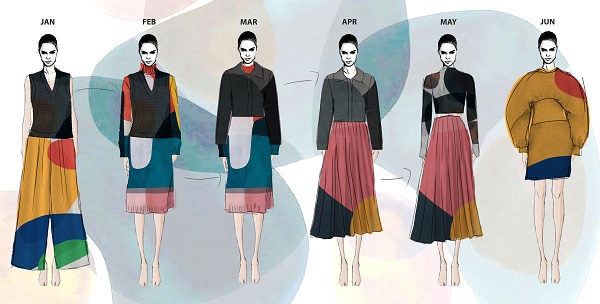
"My concept is based on the idea of use leftover yarns from knitting industry. As I already explained, it means that i can't produce 100 dresses in the same color and material because I do not have enough material, but I can produce 100 dresses with the same pattern in different colors (leftover are in different colors).
In this idea, I will separate yarns in groups (material compositions), because garments made out of for example 100% of cotton is easier to recycle. They are more recyclable.
I would like to design in two ways:
- can produce small capsule collection, one look each month. I will produce garments to present different patterns and design which are designed by my ispiration. This products I can offer to my clients.
- can work on demand, client choose type of garment, they can pick designs I already made and was presented a capsule collection (dress, pants, scarf,...), material and color group for example (pastel colors, greens, colourful, neutrals...). The final product is, because of colours, for client little surprise.
The idea is sustainable in terms of design and materials, but not in way of transport. I want to go global. Everything is connected with transport. I am not depending on material, because I'm working with leftover yarns which are always different. Knitwear is product, that allow simple production from chosen materials. Consequently knitwear is extremely flexible product which could be produced by the exchange of software via network anywhere on the world.
Modern technology offers seamless knitting, called 3D knitting, it means that garment is made out of one piece without sewing individual part of garment together. For example my company is based in Italy, but some of my clients come from United States of America. My solution is to conclude contract with manufacturer of knitwear with modern technology of 3d knitting that I explained before. My computer is via software and internet connected with his knitting machine and production can start on my demand, if yarns chosen by my client are set up in the machine. I can produce garments al over the world by using IoT (Internet of Things) and help to decrease emission in the air.
This is my idea and concept. Now i will explain my strategy how with the same garments can achieve different looks. I made plan of six styling for 6 months. Each look can contain maximum 3 gaments and one garment have to be the same in the next look (month).
In my plan I have to produce 12 pieces to achieve 6 different looks. Plan with all different garments contain 18 pieces, but I want to show how to style the same garments to make completely different looks. Mix and match, because this is slow fashion.
Here is the first idea of collection based on patterns made out of leftover yarns. Every look consist one garment form previous month. I don't want to make new fashion trends every month, but I want to make wearable and quality garments which is easy o style with other clothes and previous collections. You can see three are different color combinations, but this is just an example of the idea, because leftover are always different and unpredictable in colors.
This is the second idea of collection based on natural dying. I would make this garments or collection with yarns which are ready to dye. In previous collection have for example pattern with blue, yellow and orange. But in this idea I would make all yellows with cotton, blues with wool and oranges with linen to make same patterns that will shows up after I will dye garment. Picture present how different materials looks like after the same coloring process. Every color from previous collection is in this collection different material. I can dye garments before I sell them or sell them plain, as plain canvas which is ready to paint. In this way I will promote sustainability and clients creativity."
3) META ROGELJ
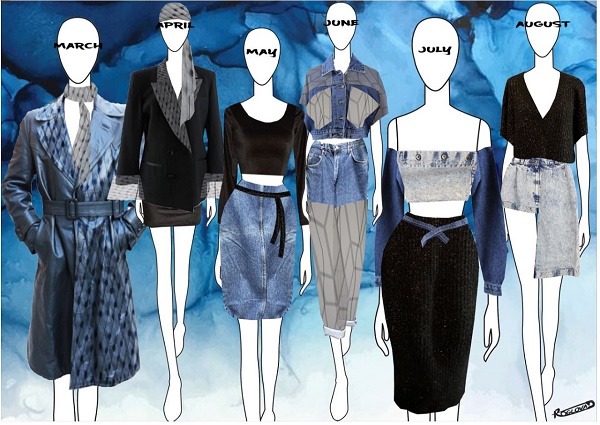
" My concept is based on upcycling and re-designing vintage and second hand clothes to make them more fashionable and wearable. Garments are designed in a way that you can style them with each other and that makes them reusable and functional."
4) NAGAYA FLORJAN-GORJUP
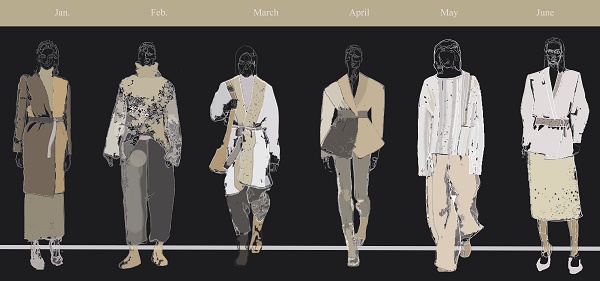
"My collection is based on only 100% hemp fabrics with variety of natural colors. I decided to use zero waste method because I'm not using any existing materials, but new sources. So therefore, at least I want to make zero waste pieces with new, sustainable fabrics. Collection is comfortable and yet, at the same time, elegant. Hemp clothes get softer with every washing. They are durable and srong, therefore clothes can be passed on to another generations. That's why I designed my collection based on unisex clothing, one size fits all. I feel to be called, to use this precious materials.
Why?
Hemp is considered to be one of the most sustainable and historical textiles ever known. The plant itself doesn't require treatment with pesticides during it's growth and it does requires less water than many other materials. It is actually nurturing the soil that's been planted in. The plant grows very fast (it can goup to four meters in just a couple of months so it's considered to be a regenerated source.) As fabrics it is 100% biodegradable, very strong and long lasting. Hemp feel fresh and cool, it is advantage for winter and summer clothing. On hot days material helps in regulating temperature between body and clothing. When outside is hot, hemp cooles us down and opposite. It's great when worn directly on the ski, it's nurturing the skin."
5) TAMARA ZORMAN
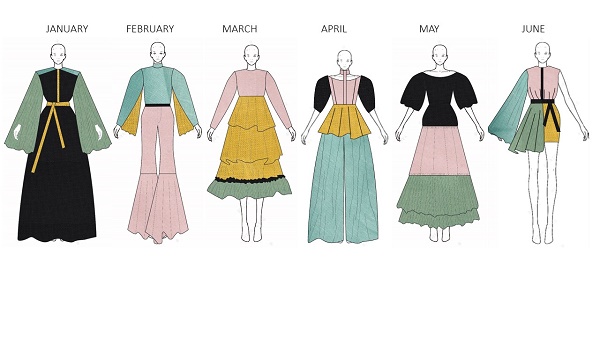
"My collection was inspired by the vase and chair. They present some gathering and fullness, which are used in my designs. 6 outfits are designed from January to June and they have mutual patterns. For example January skirt is sewn in the middle and used as April pants. Materials used are 100% linen, 100% organic cotton and non-strechwool, which is Eco-friendly and sustainable."
6) PIA ŠILEC
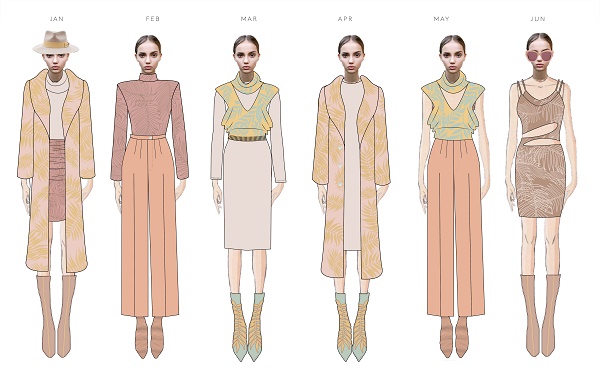
"My concept consist of a collectionsof patterns and the addition or subtractions of lining. The prints represent leaves taken from Nature that spice up my collection. With patterns I want to highlight the importance of Nature conservation. In addition two prints, the lined parts of the model, which are adaptable to the part of year, also represent a large part of the collection."
A special thanks to Damjana Celcar / Head of Fashion and Textile Design Department
Fakulteta za dizajn, Pridružena članica Univerze na Primorskem
Naturalmente, dati i tempi, tutta l'esperienza ha avuto il suo corso on line, ma non è stato difficile, in attesa di una prossima volta che non ci farà rinunciare al piacere della vicinanza e del poter visitare luoghi a me sconosciuti.
L'opportunità si è creata grazie a Mateja Benedetti fashion designer associata Web Fashion Academy nonchè eco-designer, basata a Lubjana.
Gli studenti del design, grazie a questo seminario, della moda sono stati invitati, non solo ad acquisire la conoscenza degli elementi e gli aspetti fondanti per cui un processo di produzione di beni possa essere definito circolare, ma anche a sviluppare in pochi giorni, rispettando le specifiche del protocollo di certificazione Waste Couture, 6 outfit uno per ogni mese dell'anno scelto prendendo a riferimento un semestre a piacimento.
L'impegno è stato sorprendente e ha dato come risultato ottimi lavori,
allora vi mostro e vi illustro il lavoro di:
Diellza Gashi
Lan Krebs
Meta Rogelj
Nagaya Florjan-Gorjup
Tamara Zorman
Pia Šilec
The circular economy is the economy of common sense, this is the theme of the seminar, which invited me to hold the Faculty of Design, associate member of the University of Primorska in Slovenia.
Of course, given the times we are living, the whole experience had its online course, but it was not difficult, but we will waiting for a next time that will not make us give up the pleasure of proximity and being able to visit places unknown to me.
The opportunity was created thanks to Mateja Benedetti fashion designer associated with Web Fashion Academy as well as eco-designer, based in Ljubljana precisely.
Thanks to this seminar, fashion design students were invited not only to acquire knowledge of the fundamental elements and aspects for which a process of production of goods can be defined as circular, but also to develop in a few days, respecting the specifications of the Waste Couture certification protocol, 6 outfits, one for each month of the year chosen, taking as reference a semester at will.
The effort has been amazing and has resulted in excellent works
So I'll show you and illustrate the work of:
Diellza Gashi
Lan Krebs
Meta Rogelj
Nagaya Florjan - Gorjup
Tamara Zorman
Pia Šilec
1) DIELLZA GASHI

"The point of doing those two collection, was to use vintage materials and cloths that I already have it, which are very old and made from wool and cotton. As a part of this project and also this future, I have reused old laces with materials that are biodegradable. Those laces are very old and in case to create a new product I choose to use the laces that I had and to create a new design by new techniques which makes the outfit more special. These outfits are very connected to each other, like I put a zipper on those, in case to have more options in one outfit and to not waste material for the new design. Also laces which are freezed with starch are made in that form that you can take it out and put it in again in the garment So from one outfit you can create so many combinations, and for other months there are options to combine with each other.
On another collection I choose to use an old garment , so when you invest in a vintage garment, you can rest assured that you will never walk into a room to find another person wearing the same thing you are, as this knitted jumper is, so on combination with other materials which are certificated, and biodegradale too, I combined and created a collection, which I will produce every months one of them, they are also connected with each other in case to use it again and to combined it."
2) LAN KREBS

"My concept is based on the idea of use leftover yarns from knitting industry. As I already explained, it means that i can't produce 100 dresses in the same color and material because I do not have enough material, but I can produce 100 dresses with the same pattern in different colors (leftover are in different colors).
In this idea, I will separate yarns in groups (material compositions), because garments made out of for example 100% of cotton is easier to recycle. They are more recyclable.
I would like to design in two ways:
- can produce small capsule collection, one look each month. I will produce garments to present different patterns and design which are designed by my ispiration. This products I can offer to my clients.
- can work on demand, client choose type of garment, they can pick designs I already made and was presented a capsule collection (dress, pants, scarf,...), material and color group for example (pastel colors, greens, colourful, neutrals...). The final product is, because of colours, for client little surprise.
The idea is sustainable in terms of design and materials, but not in way of transport. I want to go global. Everything is connected with transport. I am not depending on material, because I'm working with leftover yarns which are always different. Knitwear is product, that allow simple production from chosen materials. Consequently knitwear is extremely flexible product which could be produced by the exchange of software via network anywhere on the world.
Modern technology offers seamless knitting, called 3D knitting, it means that garment is made out of one piece without sewing individual part of garment together. For example my company is based in Italy, but some of my clients come from United States of America. My solution is to conclude contract with manufacturer of knitwear with modern technology of 3d knitting that I explained before. My computer is via software and internet connected with his knitting machine and production can start on my demand, if yarns chosen by my client are set up in the machine. I can produce garments al over the world by using IoT (Internet of Things) and help to decrease emission in the air.
This is my idea and concept. Now i will explain my strategy how with the same garments can achieve different looks. I made plan of six styling for 6 months. Each look can contain maximum 3 gaments and one garment have to be the same in the next look (month).
In my plan I have to produce 12 pieces to achieve 6 different looks. Plan with all different garments contain 18 pieces, but I want to show how to style the same garments to make completely different looks. Mix and match, because this is slow fashion.
Here is the first idea of collection based on patterns made out of leftover yarns. Every look consist one garment form previous month. I don't want to make new fashion trends every month, but I want to make wearable and quality garments which is easy o style with other clothes and previous collections. You can see three are different color combinations, but this is just an example of the idea, because leftover are always different and unpredictable in colors.
This is the second idea of collection based on natural dying. I would make this garments or collection with yarns which are ready to dye. In previous collection have for example pattern with blue, yellow and orange. But in this idea I would make all yellows with cotton, blues with wool and oranges with linen to make same patterns that will shows up after I will dye garment. Picture present how different materials looks like after the same coloring process. Every color from previous collection is in this collection different material. I can dye garments before I sell them or sell them plain, as plain canvas which is ready to paint. In this way I will promote sustainability and clients creativity."
3) META ROGELJ

" My concept is based on upcycling and re-designing vintage and second hand clothes to make them more fashionable and wearable. Garments are designed in a way that you can style them with each other and that makes them reusable and functional."
4) NAGAYA FLORJAN-GORJUP

"My collection is based on only 100% hemp fabrics with variety of natural colors. I decided to use zero waste method because I'm not using any existing materials, but new sources. So therefore, at least I want to make zero waste pieces with new, sustainable fabrics. Collection is comfortable and yet, at the same time, elegant. Hemp clothes get softer with every washing. They are durable and srong, therefore clothes can be passed on to another generations. That's why I designed my collection based on unisex clothing, one size fits all. I feel to be called, to use this precious materials.
Why?
Hemp is considered to be one of the most sustainable and historical textiles ever known. The plant itself doesn't require treatment with pesticides during it's growth and it does requires less water than many other materials. It is actually nurturing the soil that's been planted in. The plant grows very fast (it can goup to four meters in just a couple of months so it's considered to be a regenerated source.) As fabrics it is 100% biodegradable, very strong and long lasting. Hemp feel fresh and cool, it is advantage for winter and summer clothing. On hot days material helps in regulating temperature between body and clothing. When outside is hot, hemp cooles us down and opposite. It's great when worn directly on the ski, it's nurturing the skin."
5) TAMARA ZORMAN

"My collection was inspired by the vase and chair. They present some gathering and fullness, which are used in my designs. 6 outfits are designed from January to June and they have mutual patterns. For example January skirt is sewn in the middle and used as April pants. Materials used are 100% linen, 100% organic cotton and non-strechwool, which is Eco-friendly and sustainable."
6) PIA ŠILEC

"My concept consist of a collectionsof patterns and the addition or subtractions of lining. The prints represent leaves taken from Nature that spice up my collection. With patterns I want to highlight the importance of Nature conservation. In addition two prints, the lined parts of the model, which are adaptable to the part of year, also represent a large part of the collection."
A special thanks to Damjana Celcar / Head of Fashion and Textile Design Department
Fakulteta za dizajn, Pridružena članica Univerze na Primorskem
seminario, Faculty of Design, Waste Couture, workshop, Matea Benedetti, Università di Primorska in Slovenia.

